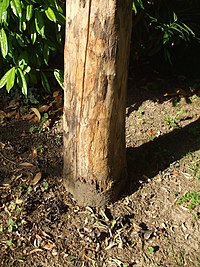Soot Bark Disease
The Rußrindenkrankheit is a fungal disease of maples .
The disease is caused by an infection with spores of the fungus Cryptostroma corticale . Diseased trees can be recognized by wilting , loss of leaves , signs of death of the crown and cambium necrosis , elongated bark and mucus flow on the trunk. Infested logs can show green and blue discoloration when cut. Infections are favored by dry and hot climates and water scarcity. The process of death can take several years. Older trees with good water supplies are less prone to infection. The disease was first observed in Germany in 2006.
When inhaled, the fungal spores can cause severe inflammation of the alveoli, accompanied by a dry cough, fever, shortness of breath and chills.
literature
- P. Robeck, R ,. Heinrich, Jörg Schumacher, R. Feindt, R. Kehr: Status of the soot bark disease of the maple in Germany . In: Yearbook of Tree Care . 2008, p. 238-244 .
Web links
- Soot bark disease on the maple on ARBOFUX - diagnostic database for trees
- Soot bark disease leads to widespread maple death on Sachsen-Sonntags-Rundschau , accessed August 22, 2019
Individual evidence
- ↑ Alfred Wulf, Sindy Leonhard, Jörg Schumacher: Fungal diseases on sycamore . In: LWF knowledge . No. 62 , p. 41–44 ( bayern.de [PDF; accessed on February 18, 2019]).
- ↑ Maple soot bark disease detected in Bavaria on www.forstpraxis.de from August 3, 2018.



